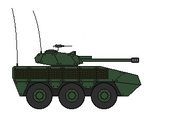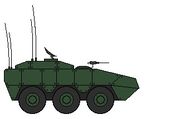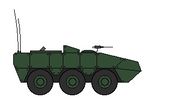Difference between revisions of "Combat Vehicle 13"
(→CV-13-TD3) |
|||
| Line 92: | Line 92: | ||
===CV-13-TD3=== | ===CV-13-TD3=== | ||
| − | [[File: | + | [[File:CV13TD2.jpg|thumb|Combat Vehicle 13-TD3]] |
(Tank Destroyer, Variant 3) | (Tank Destroyer, Variant 3) | ||
Latest revision as of 13:46, 15 January 2015
| Combat Vehicle 13 "Legionnaire" | |
|---|---|
|
300px Line drawing of a CV-13 | |
| Type | Infantry fighting vehicle |
| Place of origin |
Arcerion The United Federation of Prizyetsa |
| Service history | |
| In service | 2013-present |
| Used by | See Operators |
| Wars | n/a |
| Production history | |
| Designed | Late 2013 |
| Manufacturer | Sverd Industries |
| Number built | Over 10,000 |
| Specifications | |
| Weight | 13-20 tonnes (Mk0 to MkIII) |
| Length | 5.63 m |
| Width | 2.50 m |
| Height | 2.55 m |
| Crew |
3 (commander, gunner, driver) 8 troopers |
|
| |
Main armament |
30mm Cannon (MkI & MkII export model) 90mm cannon (MkIII export model) |
Secondary armament |
7.62 mm turret-mounted GPMG 6x 76 mm grenade launchers |
| Engine | 480hp |
| Transmission | Automatic |
| Suspension | torsion bar |
Operational range |
1,400km |
| Speed | 90 km/h |
The Combat Vehicle 13 (CV - 13) (Priz. Strittä Vagn 13 (SV-13)), is a family of Arcer 6 x 6 combat vehicles designed with the aid of The United Federation of Prizyetsa. In Prizyetsa, the CV-13 is produced and internationally marketed by Sverd Industries. The CV-13 is based upon existing armored vehicles, then improved upon by Sverd Industries and it's partners in the Legionnaire Program.
Contents
History
As both Arcerion and The United Federation of Prizyetsa were looking to replace the aging combat vehicles in their respective inventories. While both nations were already working on their own programs, the Prizyetsi program was dropped after being approached by an Arcer company working on the project. The input of both nations helped to accelerate the program. The needs and doctrines of both nations called for a highly mobile platform which could offer a high degree of customization to fill a wide range of goals which would have otherwise required a wide inventory of vehicles. The "Legionnaire Program" was the answer to all the requirements set forth by both nations.
By February of 2008, the Prizyetsi and Arcer companies officially came together to cooperate on the Legionnaire Program.
Design
The initial design of the CV-13 was agreed upon to be a six-wheeled, highly mobile fighting vehicle. It would have to have the ability to be outfitted for several jobs, therefor several variants would be built. To achieve this and make maintenance and conversion easier, a modular approach was taken to the design by creating a single "base" vehicle and then building off of it to suit each individual job.
Mobility
The Combat Vehicle 13 is built around the Siljeborg 3126 diesel engine which has an output of 350 horsepower (260kW), allowing it to reach speeds of up to 90km/h. The vehicle is fitted with 6x6 drive, offering great handling and stability as both high and low speeds. It also equipped with a central tire inflation system, which allows it to adjust to different terrain, including off road. The CV-13 is fitted with ABS braking and a traction control system (TCS). The base versions of the CV-13 do not feature amphibious capabilities.
The use of wheels offers several advantages over tracked vehicles, including lower maintenance for both the vehicle and road infrastructure, quieter movement for improved stealth, greater speed over good terrain, and higher ground clearance for protection against mines and improvised explosive devices.
Protection
One of the core requirements during the design phase of the Legionaire program was a high rate of crew survival. It was decided that the vehicle would provide this quality through means of improved mobility and advanced light-weight armor systems. The CV-13 is well protected compared to other vehicles of it's category in part thanks to the modular approach taken to the armor system used on the combat vehicle. While the CV-13 features a base layer of armor, in Prizyetsi service it has also been fitted with a variant of the Advanced Modular Protection System (AMPS) developed by Sverd Industries for use on light armored vehicles.
Armament
Sights
Variants
CV-13-APC
The CV-13-APC (Armored Personnel Carrier) is the base variant of the CV-13 family from which all other variants of the Legionnaire are based. The armored personnel carrier variant is designed primarily to deliver soldiers to and from combat zones, as well as to provide light cover once if necessary. The CV-13-APC features two rows of folding seats, facing inward, with a capacity of eight fully equipped soldiers. Alternatively, the APC variant can carry four fully equipped soldiers and two stretchers along with the combat gear of the wounded, however this requires that one of the two rows of seats be folded into it's upright position.
The CV-13-APC is currently marketed for around 1,8 million dollars per unit.
CV-13-IFV
The CV-13-IFV (Infantry Fighting Vehicle) is the lightly armed version of the CV-13-APC. The main difference between the two is the addition of the 30mm auto-cannon in the turret which is placed atop the hull. Due to the support systems needed for the turret, the infantry fighting vehicle variant of the CV-13 only has the capacity to carry six fully armed soldiers, or five if extra ammunition is carried for the cannon. Unlike the the APC variant, the CV-13-IFV is designed to offer close support to infantry. Another notable difference from the base variant is the addition of extra communications devices which provide additional channels for crews from different vehicles to communicate with one another. The final difference is the crew. Unlike that of the APC which requires only three crewman (driver, navigator, load-master), the IFV requires at least four (driver, navigator, commander/load-master, gunner).
The main weapon of this variant is the Siljeborg 30 millimeter DPLW (Dual-Purpose, Light-Weight) autocannon, also in service with the Prizyetsi navy, which offers a high rate of fire, high accuracy and precision with greatly reduced recoil. The weapon is controlled from a gunner's console within the body of the vehicle itself. There is a hatch in the turret, but this serves no operational purpose in relation with the turret or gun itself and can be used by the vehicle's commander.
The CV-13-IFV variant is currently marketed for 1,92 million NSD per unit.
CV-13-AMB
While other variants of the CV-13 are designed to cover a multitude of missions, the CV-13-AMB (Ambulance) is designed to serve one specific purpose; to offer medical assistance in the combat zone, and to ferry patients in need of critical care either to a secure landing zone for the casualties to be evacuated by air, or if this is not a possibility, to transport the casualties to a field hospital. To execute this mission successfully, the AMB has the capacity for two fully armed soldiers, four stretchers and the life-support systems which are available on-board medevac helicopters including a climate-controlled plasma bank, defibrillator kits, storage for various medical implements and several braces and tourniquets for use in emergency situations. The crew of the AMB is made up of four soldiers (driver, navigator, combat-doctor, combat-medic) which are accommodated within the vehicle. Any space mentioned for extra soldiers is not taken up by the crew. Generally, the CV-13-AMB is not armed.
The CV-13-AMB variant is currently marketed for 1,99 million NSD per unit.
CV-13-FRV
(Forward Recon Vehicle)
CV-13-CEV
(Combat Engineer Vehicle)
CV-13-TD1
(Tank Destroyer, Variant 1)
CV-13-TD2
(Tank Destroyer, Variant 2)
CV-13-TD3
(Tank Destroyer, Variant 3)
CV-13-CMD
(Command Vehicle)
CV-13-MC
(Mortar Carrier)
Operators
- Arcerion
- Palmeria operates 1,710 CV-13-IFVs.
- Pauldustllah operates 3,920 CV-13s of various variants.
- Prizyetsa operates over 6,000 CV-13s in all variants.








